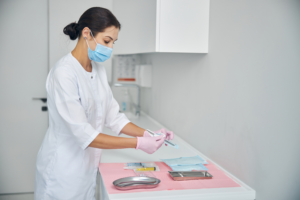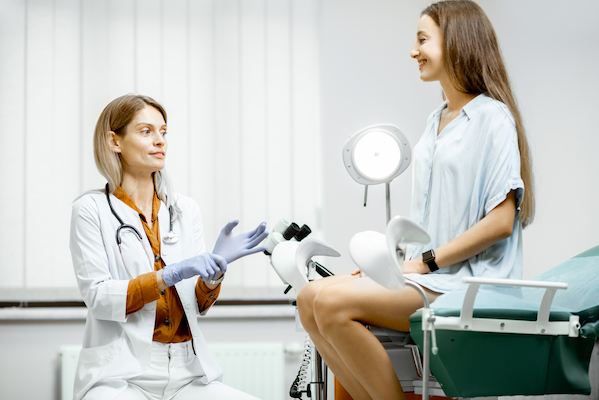Can a UTI Cause Bloating and Weight Gain? Your Guide to UTIs

Here’s a fact: Urinary Tract Infections (UTIs) cause many recognizable and uncomfortable symptoms. That burning sensation you feel ‘down there’ when you go to the bathroom is almost synonymous with a UTI. But, can a UTI cause bloating and weight gain as well?
As a matter of fact, it can!
In this article, you will learn what causes a UTI, the common symptoms associated with the infection, and how to treat it. You will also learn how a UTI can lead to bloating and weight gain.
Keep reading to discover everything you need to know about UTIs. First things first…
What is a UTI?
A Urinary Tract Infection, better known by its acronym ‘UTI,’ is a type of bacterial infection found in the urinary system. The infection can cause inflammation and irritation in the following areas:
- Kidneys
- Ureters
- Bladder
- Urethra
In women, UTIs generally appear after a transfer of bacteria occurs in or around the lower urinary tract, such as through the urethra. Then, the bacteria travel to the bladder and begin to multiply. This leads to many uncomfortable symptoms.
Common UTI Symptoms in Women
One of the easiest ways to tell if you have a UTI is during or after you urinate. For instance, if it hurts or burns when you pee, then a UTI might be the culprit. Other tell-tale signs of a UTI include:
- Foul-smelling urine
- Cloudy or bloody urine
- Pass little to no urine when you go to the bathroom, even when you have a strong urge to relieve yourself
- Frequent need to pee
- Painful to urinate (burning, irritating sensation in the urethra)
Some more symptoms of a UTI that go hand-in-hand with urination issues include:
- Pelvic pain
- Abdominal or lower back pain
- Chills
- Fever
- Nausea
- Vomiting
Along with these common UTI symptoms, the infection may also cause some other lesser-known issues. This leads us to our next point.
Can a UTI Cause Bloating and Weight Gain?

Yes, a UTI can cause bloating and weight gain. The bacteria lead to a build-up of pressure in the lower abdomen. This results in abdominal pain and bloating. In some cases, weight gain also occurs due to bloating.
But, how do you know for sure if a UTI is the source of your bloating, weight gain, or other symptoms?
You Can Always Test for a UTI
When combined with other recognizable symptoms of a UTI, such as the burning sensation during urination, then the infection is most likely the root cause of a sudden onset of bloating and weight gain symptoms.
When in doubt, you can make an appointment with your doctor to check for a UTI or test yourself at home with a self-test kit like AZO Test Strips which can be ordered online.
How to Treat a UTI
If you test positive for a UTI, then you’ll want to treat it as soon as possible. When left untreated, you run the risk of kidney infection and sepsis. Plus, UTIs have a higher chance of occurring again in the future if the first one goes untreated.
Typically, your urologist will prescribe you antibiotics to combat the bad bacteria. Your symptoms should clear up within a few days. If you continue to experience discomfort after 3 days, contact your doctor for a follow-up appointment. Probiotics are also effective in helping your body fight many kinds of infections including UTIs.
Additionally, be sure to drink plenty of fluids. This will help regulate your body and flush out the bad bacteria.
Top Tips to Prevent UTIs
UTIs are no fun. For obvious reasons, you’ll want to do your best to avoid them in the future! Along with regular exercise and a healthy diet, here are 5 tips for UTI prevention.
1. Stay Hydrated
Dehydration exacerbates UTIs. Although dehydration alone isn’t the root cause of a UTI, it can make things a lot worse.
Drink water every day to keep your body running smoothly, especially if you feel the onset of UTI symptoms. You can also try Hydration IV Therapy to replenish your body before, during, and after treatment.
2. Drink Cranberry Juice

Along with water, pour yourself a glass of cranberry juice. Believe it or not, Cranberry juice can help UTIs. The tannins found in cranberry juice actually fight bad bacteria from sticking to the wall of the bladder. Therefore, it’s a great way to prevent infections right from the start.
Vitamin C and probiotics will also help you deal with UTIs, which means a diet full of fruits and vegetables is always a plus!
3. Urinate After Sex
Be sure to urinate after sex. You may have heard this advice before, however, it is extremely effective. Here’s why it is so vital:
For women, sex is one of the leading causes of UTIs. During sex, bacteria from contaminated areas can easily enter the body through the urethra. For instance, the urethra is very close to the rectum, which is a common place for UTI-causing bacteria like E.coli.
To prevent a UTI from forming, simply go to the bathroom within 30 minutes after sex. When you urinate, you will kill and flush out any bad bacteria that entered through the urethra.
4. Wear Cotton Underwear
An easy way to avoid a UTI is to keep the genital area dry. Tight clothing and synthetic underwear (such as nylon) can irritate the genital area and encourage bacteria growth.
One of the best alternatives is cotton. Cotton garments are breathable and less likely to trap excess moisture. Opt for panties rather than thongs to further encourage breathability, especially if you are currently experiencing a UTI.
5. Improve Bathroom Hygiene

Down there care is extremely important when it comes to UTI prevention.
For starters, wipe from front to back after you use the restroom. This will help you avoid contaminating your genitals with unwanted bacteria.
Next, only use sanitary feminine products. Don’t use a pad, tampon, or protective underwear that has been opened and taken out of its protective casing or wrapper. Furthermore, change your feminine products regularly to keep bacteria at bay.
Get UTI Relief at Whole Health JC
Experiencing UTI symptoms? Don’t go untreated!
At Whole Health JC, we test and treat Urinary Tract Infections (UTIs) and other vaginal infections. Contact us directly at 573-893-5500 to schedule a same-day visit so you can find fast relief.


















